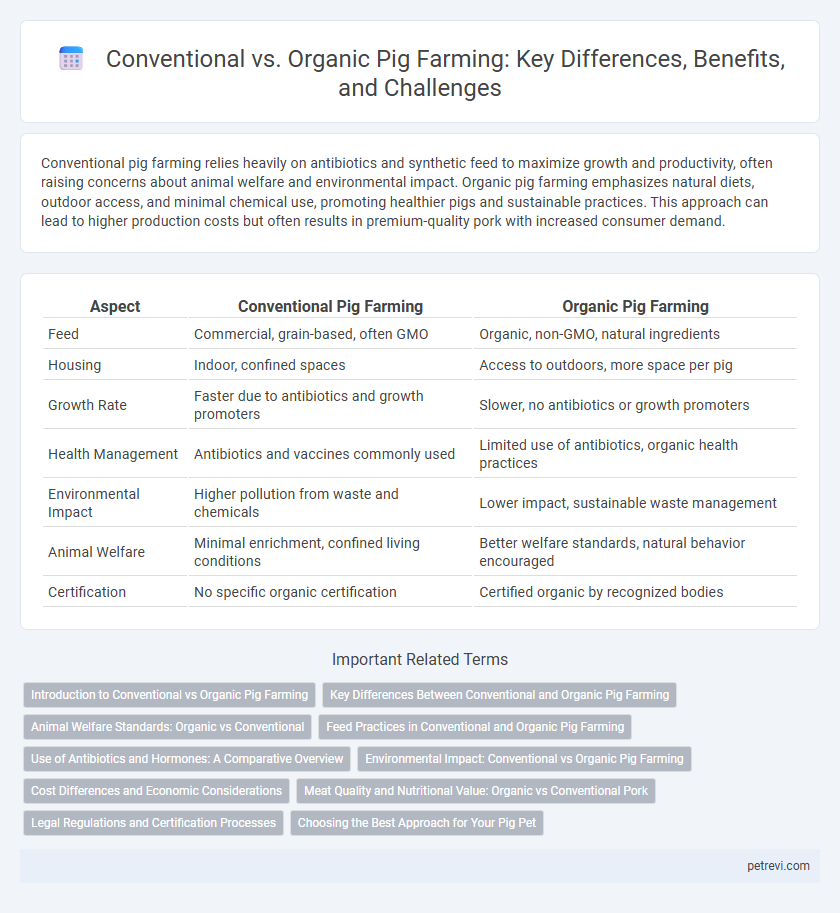Conventional pig farming relies heavily on antibiotics and synthetic feed to maximize growth and productivity, often raising concerns about animal welfare and environmental impact. Organic pig farming emphasizes natural diets, outdoor access, and minimal chemical use, promoting healthier pigs and sustainable practices. This approach can lead to higher production costs but often results in premium-quality pork with increased consumer demand.
Table of Comparison
| Aspect | Conventional Pig Farming | Organic Pig Farming |
|---|---|---|
| Feed | Commercial, grain-based, often GMO | Organic, non-GMO, natural ingredients |
| Housing | Indoor, confined spaces | Access to outdoors, more space per pig |
| Growth Rate | Faster due to antibiotics and growth promoters | Slower, no antibiotics or growth promoters |
| Health Management | Antibiotics and vaccines commonly used | Limited use of antibiotics, organic health practices |
| Environmental Impact | Higher pollution from waste and chemicals | Lower impact, sustainable waste management |
| Animal Welfare | Minimal enrichment, confined living conditions | Better welfare standards, natural behavior encouraged |
| Certification | No specific organic certification | Certified organic by recognized bodies |
Introduction to Conventional vs Organic Pig Farming
Conventional pig farming relies on intensive production methods, utilizing synthetic fertilizers, pesticides, and antibiotics to maximize growth and feed efficiency. Organic pig farming emphasizes natural feed, outdoor access, and prohibits synthetic chemicals and routine antibiotic use, promoting animal welfare and environmental sustainability. Understanding these fundamental differences helps evaluate their impact on pork quality, farm profitability, and ecological footprint.
Key Differences Between Conventional and Organic Pig Farming
Conventional pig farming relies on synthetic antibiotics, growth promoters, and high-density housing to maximize production efficiency, while organic pig farming emphasizes natural feed, antibiotic-free practices, and lower stocking densities to enhance animal welfare. Organic systems prioritize environmental sustainability through organic feed and restricted chemical use, contrasting with conventional methods that often depend on synthetic fertilizers and pesticides for feed crops. The key differences lie in the management of animal health, feed sources, and environmental impact, shaping distinct approaches to pig welfare and product quality.
Animal Welfare Standards: Organic vs Conventional
Organic pig farming enforces stricter animal welfare standards by providing pigs with outdoor access, more space, and natural bedding, promoting natural behaviors and reducing stress. Conventional pig farming often involves confined housing with limited movement and standard veterinary treatments, prioritizing productivity over welfare aspects. Enhanced welfare in organic systems results in healthier pigs and meets growing consumer demand for ethically raised pork.
Feed Practices in Conventional and Organic Pig Farming
Conventional pig farming commonly uses grain-based feeds supplemented with synthetic amino acids, vitamins, and minerals to maximize growth efficiency and feed conversion ratios. Organic pig farming relies on certified organic feed, free from genetically modified organisms (GMOs), synthetic pesticides, and artificial additives, promoting natural growth and animal welfare. The organic feed often includes foraged plants, legumes, and grains grown without synthetic chemicals, ensuring compliance with organic certification standards.
Use of Antibiotics and Hormones: A Comparative Overview
Conventional pig farming typically employs antibiotics and hormones to promote growth and prevent disease, which can lead to antibiotic resistance and residual hormone presence in meat products. In contrast, organic pig farming restricts the use of synthetic antibiotics and hormones, relying instead on natural remedies, genetic selection, and improved living conditions to maintain animal health. This difference significantly impacts consumer preference, food safety standards, and regulations within the pork production industry.
Environmental Impact: Conventional vs Organic Pig Farming
Conventional pig farming often relies on concentrated animal feeding operations (CAFOs), which can lead to significant environmental concerns such as water pollution from manure runoff and higher greenhouse gas emissions. Organic pig farming employs pasture-based systems that promote better waste management and reduce nutrient leaching, contributing to improved soil health and biodiversity. Studies indicate that organic pig farming generally has a lower carbon footprint and less environmental degradation compared to conventional methods.
Cost Differences and Economic Considerations
Conventional pig farming generally incurs lower production costs due to higher stocking densities, use of synthetic feed, and conventional veterinary treatments, resulting in more predictable and scalable outputs. Organic pig farming demands higher investments in organic feed, longer growth periods, and compliance with animal welfare standards, increasing overall expenses and reducing profit margins. Economic considerations must balance higher market prices for organic pork against increased operational costs and potential yield variability.
Meat Quality and Nutritional Value: Organic vs Conventional Pork
Organic pork often contains higher levels of omega-3 fatty acids and antioxidants compared to conventional pork, enhancing its nutritional profile. Conventional pig farming typically relies on synthetic additives and antibiotics, which can impact meat quality and consumer health perceptions. Studies indicate that organic pork may offer improved flavor, tenderness, and overall meat quality due to natural feed and stress-free rearing conditions.
Legal Regulations and Certification Processes
Conventional pig farming is regulated primarily by the USDA's Food Safety and Inspection Service (FSIS), adhering to standards on animal welfare, waste management, and antibiotic use, but often allows growth promotants and routine antibiotics. Organic pig farming requires certification under the USDA National Organic Program (NOP), mandating strict prohibitions on synthetic hormones, antibiotics, and genetically modified feed, alongside enhanced animal welfare and outdoor access requirements. Compliance with organic certification involves thorough documentation, annual on-site inspections, and adherence to organic feed and pasture standards, ensuring traceability and transparency throughout the production process.
Choosing the Best Approach for Your Pig Pet
Conventional pig farming often relies on antibiotics and synthetic feeds to maximize growth and prevent disease, while organic pig farming emphasizes natural diets, antibiotic-free practices, and outdoor access for improved animal welfare. Choosing the best approach for your pig pet depends on prioritizing health benefits and sustainability, with organic methods reducing exposure to chemical residues and promoting natural behaviors. Evaluating factors such as feed quality, housing conditions, and veterinary care helps ensure a balanced decision tailored to your pig's well-being and longevity.
Conventional vs Organic for Pig Farming Infographic

 petrevi.com
petrevi.com